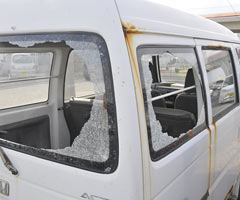Typhoon No.2 hits Okinawa with unusual ferocity, causing heavy damage

Car windscreen broken by the strong winds of Typhoon No.2 on the afternoon of May 30 at the Sarahama port, in the Irabu district of Miyakojima City.
May 31, 2011 Hiroko Sato of Ryukyu Shimpo
Typhoon No. 2 lashed the Okinawa area during the two days of May 28 and 29, causing extensive damage. A total of 68 injuries had been reported by May 30, including two people in a critical condition. According to prefectural government statistics, at least in the last ten years, there has never been a case in which the injury toll exceeded 60 people for a typhoon in May. This is the first time among such May typhoons that a maximum wind speed of more than 100 knots has been recorded since the Okinawa Meteorological Observatory commenced recording statistics in 1951. “This is an exceptional typhoon for May,” said an official at the observatory. The Disaster Risk Management Division of the prefectural government issued an alert, warning: “Do not go outside during the typhoon, and take storm protection measures to cover window glass.”
The Annual Report of the Prefectural Emergency Management shows that in the past ten years there have been two cases of typhoons causing more than 60 casualties – in September in 2003 and the same month in 2006. Typhoon No. 14 of September 2003 inflicted the most serious damage with 94 people with minor and serious injuries with one person killed. Typhoon No. 13 of September 2006 caused injuries ranging from minor to critical to 66 people, and in 2010, a total of 18 people were injured by the four typhoons that occurred that year.
The Risk Management Division of the prefectural government explains, “We think that many people were injured by broken glass or were knocked over by the typhoon’s strong winds.” They speculate that, “The particularly strong winds have made the damage worse,” and once they analyze the damage over the whole area they will consider what measures might be taken in future.
According to Observatory staff, the previous strongest winds had been recorded at 84.9 knots in Miyakojima in 1951, and 59.5 knots on Okinawa’s main island in 2001. An average of 0.4 typhoons hit Okinawa each May, but it is the first time that two typhoons, No. 1 followed by No. 2, came in such quick succession. Two typhoons hit in May 1966, but not so close to each other.
With regard to typhoons in May, the senior forecaster at the Observatory, Masaru Shimajiri, explained that, “A tropical cyclone was likely to occur because of meandering westerlies with vigorous convective activity over the sea east of the Philippines. In this region typhoons usually change their course and slow down, but No 2. was very unusual. It increased its speed to approximately 80 to 100 knots around Okinawa,” he said. The senior forecaster suggested that, “The meandering westerlies may have increased the speed of the wind.”
(English Translation by T&CT, Mark Ealey)
Slideshow of Typhoon No.2’s picture(interval 5sec)
Previous Article:The Ritz-Carlton expands its operation to Kise Bettei in Nago City
Next Article:Relocation of Tori Shima Range to Iwo-Tori-shima
[Similar Articles]
- Typhoon Lingling reaches highest wind speed in recorded history at Miyako Airport
- Typhoon Goni causes damages of 780 million yen to agriculture, fisheries in Okinawa
- Disaster Relief Act applied to Yonaguni, where damages of more than 100 million yen caused by Typhoon Dujuan
- Typhoon Neoguri leaves 40 people injured and 2.2 billion yen in agricultural damage
- Gust of wind bends 20 pillars at golf course in Tomigusuku
 Webcam(Kokusai Street)
Webcam(Kokusai Street)


